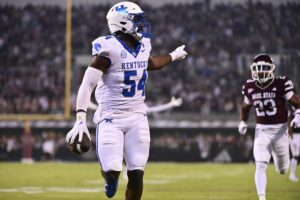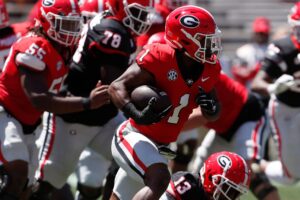Several months ago, we began our series analyzing the impact of the NCAA announcement to begin compensating student-athletes for their name, image, and likeness (“NIL”). That series started in earnest without discussion of the California “Fair Pay to Play Act.” Shortly thereafter, we reported that the NCAA instructed its divisions to investigate and implement rules allowing NIL compensation. Then we examined who will likely control the payments. Most recently, we pondered what limits on NIL compensation the NCAA might impose. Now, we move forward to some of the more interesting questions. In this part, we begin assessing the impact of NIL compensation on recruiting.
Assessing the Impact of NIL Compensation on Recruiting
Recruiting, in General
Recruiting is the lifeblood of college athletics. Unlike professional leagues that hold balanced drafts, the NCAA permits each school to recruit and sign a set limit of players. Since services like Rivals and 247Sports starting tracking rankings, however, recruiting has been imbalanced. Based on 247Sports’ composite rankings, the list of five-star talent stands at 33 such players annually on average. Players filling out the five-star rankings include upper-tier NFL talent like Calvin Ridley, Leonard Fournette, Myles Garrett, Dalvin Cook, etc.
While not every five-star player pans out, a far greater percentage make immediate college impact. We offer no surprise, then, in saying that teams regularly recruiting the most star-powered talent outperform others. Over the last five years, for example, five teams own over half of the five-star talent. That list features Georgia, Alabama, Ohio State, Clemson, and LSU. In any given year, an average of just seven teams claim multiple five-star recruits. And those teams, on average, net 75% of that caliber of talent.
Recruiting, in general, favors a handful of teams. Sometimes, teams climb into the top five who have not been there regularly. Dabo Swinney’s Clemson teams offer the most recent example there. To the contrary, teams also fall off this coveted list from time to time. Notre Dame and Florida State offer the most recent examples of this. In all but a few rare cases, however, a team does not just catapult into the top five from nowhere. Traditional powers recruit well based on success on the field and success in placing talent into the NFL. None of this, of course, is earth-shattering.
Recruiting, in Flux
The biggest differences (arguably, anyway) between professional teams and college teams are notable. First, professional teams can offer big paychecks to big talent and lure players in that way. Second, professional teams can level the playing field through a draft system designed to do just that. Third, teams can both rebuild and fine-tune rosters through annual free agency and trade markets. Because college recruiting relies on prestige, the best teams tend to stay the best teams for decades at a time. While some question the role money plays in that spread (for example, the infamous but ever-elusive SEC “bag men”), it currently plays less of a role than it does in professional athletics.
In recent years, however, the policy supporting the hard line in the sand drawn between student-athletes and money has come under serious fire. As schools’ respective paychecks continue to grow rapidly, questions over whether a scholarship adequately compensates players for the product they offer to the consumers. Sure, the old way makes some sense, too. Student-athletes compete for glory and for a chance to hear their names called by the big leagues. That introduces a level of raw passion–poetry, for many–to college athletics that professional leagues cannot duplicate. Regardless where one stands on that debate, however, the truth is out. NIL compensation is happening. Student-athletes will now derive at least some profit from their names while playing college sports.
One large question looms, then, as the NCAA investigates the mechanics of the NIL compensation is has already approved. How will this change recruiting?
Recruiting, with Money?
If the NCAA cannot otherwise balance its Title IX obligations with the imbalance likely to stem from NIL compensation across the several sports, then the NCAA could punt altogether on exercising control over compensation mechanics. It may implement some broad rules, but it could otherwise leave much of the logistics to the divisions and conferences. Alternatively, it could, especially if the California model carries the day, offer no guidance or control at all. If this happens, then schools would quite literally start recruiting with money. This time, however, it would happen in the open.
In some ways, this might offer an improvement. Those who take the most cynical view could argue that, right now, only a handful of teams have the audacity and means to pay student-athletes under the table. Thus, the same five to eight schools willing to do so emerge with the best recruits each year. Bringing this out in the open could level the playing field. One can find a lot to like in this position. On the other hand, teams with the richest alumni might simply replace those with the richest tradition on the top rungs of the recruiting ladder. UCLA, USC, Michigan, Notre Dame, and Stanford could replace Alabama, Georgia, Clemson as the best-recruiting Power Five schools.
Regardless of the mechanics of NIL compensation, however, the NCAA remains unlikely to relinquish all control over these issues, even if Title IX complicates the balancing act. The most likely outcome is that the NCAA will set forth general rules to maintain some semblance of fairness while relinquishing control over the compensation limits and income streams to the conferences and schools. As a result, the biggest impact of money on recruiting might be delayed.
Recruiting, Balanced?
As the NCAA assesses the impact of NIL compensation on recruiting, there is no doubt it is considering many alternatives. Regardless, the NCAA will not willingly allow parties to openly influence recruits with endorsement dollars. Thus, even though the rules will change to allow NIL compensation, the recruiting rules might well offer even stricter constraints on permissible recruiting methods. With the introduction of this new source of compensation, the NCAA will no doubt adhere to its talking points on this topic. As we discussed in the first part of our series, the NCAA remains focused on preserving the division between students and professionals and on maintaining competitive balance.
To preserve that balance, the NCAA will closely guard against the influence of those responsible for the NIL checks. Schools should not be permitted to publish average compensation numbers. Coaches should not be permitted to share this with recruits. Those purchasing NIL rights or licenses should not be permitted to contact recruits, either directly or indirectly. And schools found to be fostering a culture that promotes sharing of these statistics should be punished swiftly and severely. At least, these things should happen in an ideal world where the NCAA is serious about preserving these values.
If the NCAA does that, then, in our view, the injection of NIL compensation into the student-athletes’ expectations might introduce more fairness than currently exists. A big-time recruit might be far less enticed by under-the-table money if he knows that he will receive NIL compensation checks routinely. And that might make all the difference in the world. It certainly cannot hurt, anyway.
Main Photo Credit:







